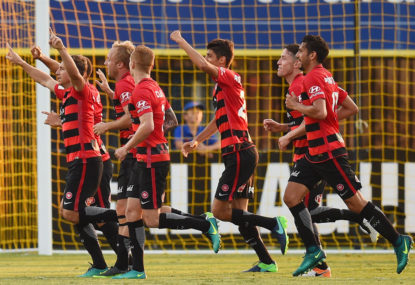Brett Wilson
new author
Roar Rookie

The FFA has recently announced that it intends to expand the A-League to 12 teams for the 2017-18 season.
Given the FFA has sought input from potential broadcasters, it is expected that they will choose additional teams in the most populous state capitals, Sydney and Melbourne.
Of the other potential bids, a team from Tasmania appears to be the sentimental favourite among neutrals. They would be the first team in the four major football codes to represent the Apple Isle in top tier competition.
This could be positive in terms of hearts and minds, junior participation and interest among a population exceeding 500,000. The bid appears to have some significant political, financial and football clout and the timing could be a perfect storm.
The point to this article is, why choose two of the three? Instead, the FFA should admit three additional teams. ‘That’s crazy’ I hear you say. That would mean a bye every weekend. However, is that so bad? That would mean 69 additional full time footballers (likely 54 locals given visa players). Again, is that so bad given participation levels and the size and quality of the NPL? Expanding by two teams would lead to 46 extra players and 36 locals anyway.
There would still be six matches each weekend. The FFA would still get its additional ‘derbies’ in Melbourne and Sydney. Better still, the A-League would comprise 12 Australian teams. 12 is the magic number in teams of Asian Champions League qualification. 12 Australian teams means four ACL slots. However, 11 Australian teams means only three ACL slots.
Further, 13 teams means one less bid rejected by the FFA. One less bunch of supporters disenfranchised by the governing body. If a team from Tasmania cannot get admitted now, they might not apply again when the FFA ultimately look to move to 16 teams, or whatever number is ultimately settled upon.
Another advantage with 13 teams is that it gives the FFA some insurance. If those pesky ‘Nix don’t meet their ‘metrics’, or if the Mariners finally go broke, the FFA can revert to a 12-team format instead of having to find a new team on short notice in order to meet their obligations.
It would be expected that the new clubs will target teams with depth (such as Sydney) thereby stopping the stockpiling of players, and all teams would need to look more to the NPL and youth squads to fill slots 20-23 of their roster. There is clearly more talent in the NPL than just Danny Choi or Jai Ingham.
Two NPL teams won FFA Cup matches against A-League opposition this year. Further, less players would end up on the A-League ‘scrap heap’ each season, as out-of-favour players at one club may be in demand at another.
What then of the length of the competition? Twelve teams would lead to 22 rounds if everyone plays everyone else twice, or 33 rounds if everyone plays everyone else three times.
Do we really want teams playing each other three times in a 12 or 13-team competition, followed by a semi-finals series for the top teams? We can normally tell by February who the cream of the crop is. In the current competition, by weeks 20-27, crowd interest in poorly performing teams has waned and TV ratings for non-relevant games plummet. Last season only 25,000 tuned in to watch Sydney FC play the Mariners in Round 24. To put this in context, 105,000 watched WSW host Victory at ANZ Stadium last Saturday.
Instead, it is proposed to play two full rounds (home and away), comprising 26 weeks with competition points carrying over, then the top seven play off on a round robin over a further seven weeks for the Premiership. That’s three semi-final-like quality matches each weekend for seven weeks. This could then by followed by a two week finals series, i.e. second versus third with the winner to play the Premiers in the grand final.
Why a seven-team round robin? Well the answer is teams are likely to be still participating in the ACL at the business end of the A-League season. Byes can be programmed during the round robin as well as the regular season to assist those teams, so that they do not have to choose which silverware they want to try and win.
From a player welfare perspective, the top teams will receive three byes, rather than being required to play on 30 consecutive weekends on top of some midweek FFA Cup or postponed matches. Further, byes can be structured to avoid back-to-back short turnarounds.
What of the bottom six? Well, as there is no promotion and relegation yet (that’s a whole different article) they have nothing to play for after Round 26, and so they do not play. We are spared third edition of Wellington versus Newcastle* or games of similar ilk that have no bearing on anything (*assuming these teams perform as they have in the past few years).
The advantages in expanding to 13-teams clearly outweighs the disadvantages.